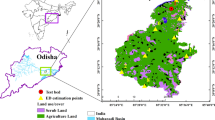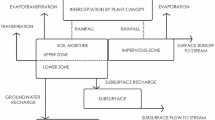Abstract
The well-known White method (A method of estimating ground-water supplies based on discharge by plants and evaporation from soil: Results of investigation in Escalante Valley, Utah. Washington D.C, US Geological Survey. Water Supply Paper 659-A United States Department of the Interior, 1932) based on diurnal water table observations has been widely applied to estimate groundwater evapotranspiration (ETG) from phreatophyte vegetation. One of the limitations of this method is its large uncertainties in quantifying the daily groundwater recovery rate (r), which is assumed to be equal to the average rate of groundwater level rise between midnight (i.e., 00:00 h) and 04:00 h. Recent studies pointed out that ETG is highly dependent on the shape and duration of the diurnal clear-sky solar radiation curve and that using the groundwater recovery rate over a short interval of nighttime hours to represent the daily r may lead to large uncertainties in ETG estimates. In this study, we analysed the dependence of the estimated daily r on the sunset and sunrise timings. Numerical experiment results showed that the estimated r is highly sensitive to the duration between sunset and sunrise, which varies seasonally. Instead of using fixed time spans (TSs), e.g., from midnight to 04:00 h, we recommend a more universal method for determining the TS, which is associated with the sunset and/or sunrise timings and used to estimate the daily r. This dynamic TS approach was tested at a Tamarix ramosissima-dominated riparian site with a hyper-arid climate (precipitation of 35 mm a−1) in northwestern China. Compared with the observed evapotranspiration (ET), our approach showed better performance and less subjectivity in estimating ETG than the traditional White approach.




Similar content being viewed by others
References
Fahle M, Dietrich O (2014) Estimation of evapotranspiration using diurnal groundwater level fluctuations: comparison of different approaches with groundwater lysimeter data. Water Resour Res 50:273–286. https://doi.org/10.1002/2013WR014472
Gribovszki Z, Kalicz P, Szilágyi J, Kucsara M (2008) Riparian zone evapotranspiration estimation from diurnal groundwater level fluctuations. J Hydrol 349:6–17. https://doi.org/10.1016/j.jhydrol.2007.10.049
Liu S, Graham WD, Jacobs JM (2005) Daily potential evapotranspiration and diurnal climate forcings: influence on the numerical modelling of soil water dynamics and evapotranspiration. J Hydrol 309:39–52. https://doi.org/10.1016/j.jhydrol.2004.11.009
Loheide SP (2008) A method for estimating subdaily evapotranspiration of shallow groundwater using diurnal water table fluctuations. Ecohydrology 1:59–66. https://doi.org/10.1002/eco.7
Martinet MC, Vivoni ER, Cleverly JR, Thibault JR, Schuetz JF, Dahm CN (2009) On groundwater fluctuations, evapotranspiration, and understory removal in riparian corridors. Water Resour Res 45:05425. https://doi.org/10.1029/2008wr007152
Meinzer OE (1927) Plants as indicators of ground water. US Geological Survey Water-Supply paper 577, Washington
Miller GR, Chen X, Rubin Y, Ma S, Baldocchi DD (2010) Groundwater uptake by woody vegetation in a semiarid oak savanna. Water Resour Res 46:W10503. https://doi.org/10.1029/2009WR008902
Soylu ME, Lenters JD, Istanbulluoglu E, Loheide SP II (2012) On evapotranspiration and shallow groundwater fluctuations: a fourier-based improvement to the White method. Water Resour Res 48:W06506. https://doi.org/10.1029/2011wr010964
Wang P, Pozdniakov SP (2014) A statistical approach to estimating evapotranspiration from diurnal groundwater level fluctuations. Water Resour Res 50:2276–2292. https://doi.org/10.1002/2013WR014251
Wang P et al (2014) Application of the water table fluctuation method for estimating evapotranspiration at two phreatophyte-dominated sites under hyper-arid environments. J Hydrol 519(Part B):2289–2300. https://doi.org/10.1016/j.jhydrol.2014.09.087
Wang P et al (2018) Implementing dynamic root optimization in Noah-MP for simulating phreatophytic root water uptake. Water Resour Res 54:1560–1575. https://doi.org/10.1002/2017WR021061
Wang TY, Yu JJ, Wang P, Min LL, Pozdniakov SP, Yuan GF (2019) Estimating groundwater evapotranspiration by phreatophytes using combined water level and soil moisture observations. Ecohydrology. https://doi.org/10.1002/eco.2092
White WN (1932) A method of estimating ground-water supplies based on discharge by plants and evaporation from soil: Results of investigation in Escalante Valley, Utah. Washington D.C, US Geological Survey. Water Supply Paper 659-A United States Department of the Interior
Yin L, Zhou Y, Ge S, Wen D, Zhang E, Dong J (2013) Comparison and modification of methods for estimating evapotranspiration using diurnal groundwater level fluctuations in arid and semiarid regions. J Hydrol 496:9–16. https://doi.org/10.1016/j.jhydrol.2013.05.016
Yuan G, Zhang P, Shao M-a, Luo Y, Zhu X (2014) Energy and water exchanges over a riparian Tamarix spp. stand in the lower Tarim River basin under a hyper-arid climate. Agric For Meteorol 194:144–154. https://doi.org/10.1016/j.agrformet.2014.04.004
Yuan G, Luo Y, Shao M, Zhang P, Zhu X (2015) Evapotranspiration and its main controlling mechanism over the desert riparian forests in the lower Tarim River Basin. Sci China Earth Sci 58:1032–1042. https://doi.org/10.1007/s11430-014-5045-7
Yue W, Wang T, Franz TE, Chen X (2016) Spatiotemporal patterns of water table fluctuations and evapotranspiration induced by riparian vegetation in a semiarid area. Water Resour Res 52:1948–1960. https://doi.org/10.1002/2015WR017546
Zhang P, Yuan G, Shao M, Yi X, Du T (2016) Performance of the White method for estimating groundwater evapotranspiration under conditions of deep and fluctuating groundwater. Hydrol Process 30:106–118. https://doi.org/10.1002/hyp.10552
Acknowledgements
This research was supported by grants from the National Natural Science Foundation of China (Nos. 41671023 and 41877165), the National Natural Science Foundation of the China-Russian Foundation for Basic Research (NSFC-RFBR) Programme 2018–2019 (Nos. 41811530084 and 18-55-53025 ГФEH_a), and the China Geological Survey Project (Grant DD20190504). Ping Wang and Sergey P. Pozdniakov are grateful for support by the Special Exchange Program of Chinese Academy of Sciences 2019–2020. Special thanks to Dr. Guofu Yuan from the IGSNRR, Chinese Academy of Sciences, for providing data from a riparian Tamarix spp. stand in the lower Tarim River basin. The authors gratefully acknowledge the editor, James W. LaMoreaux, and the anonymous reviewers for their valuable comments and suggestions, which have led to substantial improvements over an earlier version of the manuscript.
Author information
Authors and Affiliations
Corresponding authors
Additional information
Publisher's Note
Springer Nature remains neutral with regard to jurisdictional claims in published maps and institutional affiliations.
Rights and permissions
About this article
Cite this article
Wang, TY., Wang, P., Yu, JJ. et al. Revisiting the White method for estimating groundwater evapotranspiration: a consideration of sunset and sunrise timings. Environ Earth Sci 78, 412 (2019). https://doi.org/10.1007/s12665-019-8422-x
Received:
Accepted:
Published:
DOI: https://doi.org/10.1007/s12665-019-8422-x




